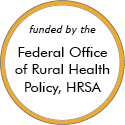Rural Project Examples: Pharmacy and prescription drugs
Effective Examples
Project Lazarus
Updated/reviewed May 2024
- Need: To reduce overdose-related deaths among prescription opioid users in rural Wilkes County, North Carolina.
- Intervention: Education and tools are provided for prescribers, patients and community members to lessen drug supply and demand, and to reduce harm in prescription opioid use.
- Results: Opioid overdose death rates have decreased in Wilkes County.
Promising Examples
The Rural Virtual Infusion Program

Updated/reviewed November 2025
- Need: Allow rural cancer patients in a region inclusive of 26 counties in Iowa, Minnesota, and South Dakota to have access to tertiary-level chemotherapy regimens administered in rural infusion centers.
- Intervention: With telehealth-based oversight from a tertiary care oncology team, 3 rural infusion teams were trained to coordinate cancer treatment plans and administer complex chemotherapy regimens.
- Results: The original grant-supported effort — with its results of saving130 patients 65,000 trip miles and 1,800 travel hours – proved sustainable.
Other Project Examples
Queen Anne's County Mobile Integrated Community Health (MICH) Program
Updated/reviewed May 2025
- Need: To connect patients to resources in order to reduce use of emergency services, emergency department visits, and hospital readmissions.
- Intervention: Patients receive support (by in-person visit, phone call, or telehealth visit) from a paramedic, community health nurse, peer recovery specialist, and pharmacist.
- Results: Between July 2016 and March 2024, the program made 1,098 patient contacts and continued to see a reduction in emergency department and inpatient visits and costs.
HCC of Lafayette County's Heath Information Technology Workgroup

Updated/reviewed December 2023
- Need: To ensure the quality and sustainability of rural West Central Missouri's health services through the use of technology.
- Intervention: The Health Care Coalition of Lafayette County convened a Health Information Technology (HIT) workgroup to establish electronic medical and prescription records, telemedicine capabilities, and training for Lafayette County and surrounding areas.
- Results: The workgroup fully equipped a local emergency department with HIT, launched electronic prescriptions for nearly a dozen Lafayette County providers, and identified acute needs hindering the adoption of electronic health records.
Southwest Health System Antibiotic Stewardship Program
Updated/reviewed March 2021
- Need: Impact patient care and safety issues related to antibiotic use in southwest Colorado.
- Intervention: Pharmacy-led antibiotic stewardship program for inpatient, outpatient, and long-term care settings.
- Results: With antibiotic use guidelines, refined infection diagnostics, and first-choice antibiotic selections, all care settings now see decreased days of treatment and decreased resistance patterns.
Ohio Northern University's HealthWise Mobile Outreach Program

Updated/reviewed July 2019
- Need: Meeting both advanced practice pharmacy student education needs and patient healthcare needs in a nearby rural/underserved area.
- Intervention: With support from multiple organizations, students in the Ohio Northern University's College of Pharmacy program use a motor coach to deliver a wide range of healthcare services during scheduled outreach visits.
- Results: In the program's first two years, point-of-care screening, immunizations, and chronic disease prevention and management education have been provided to 800+ Hardin County, Ohio, residents.
For examples from other sources, see:
